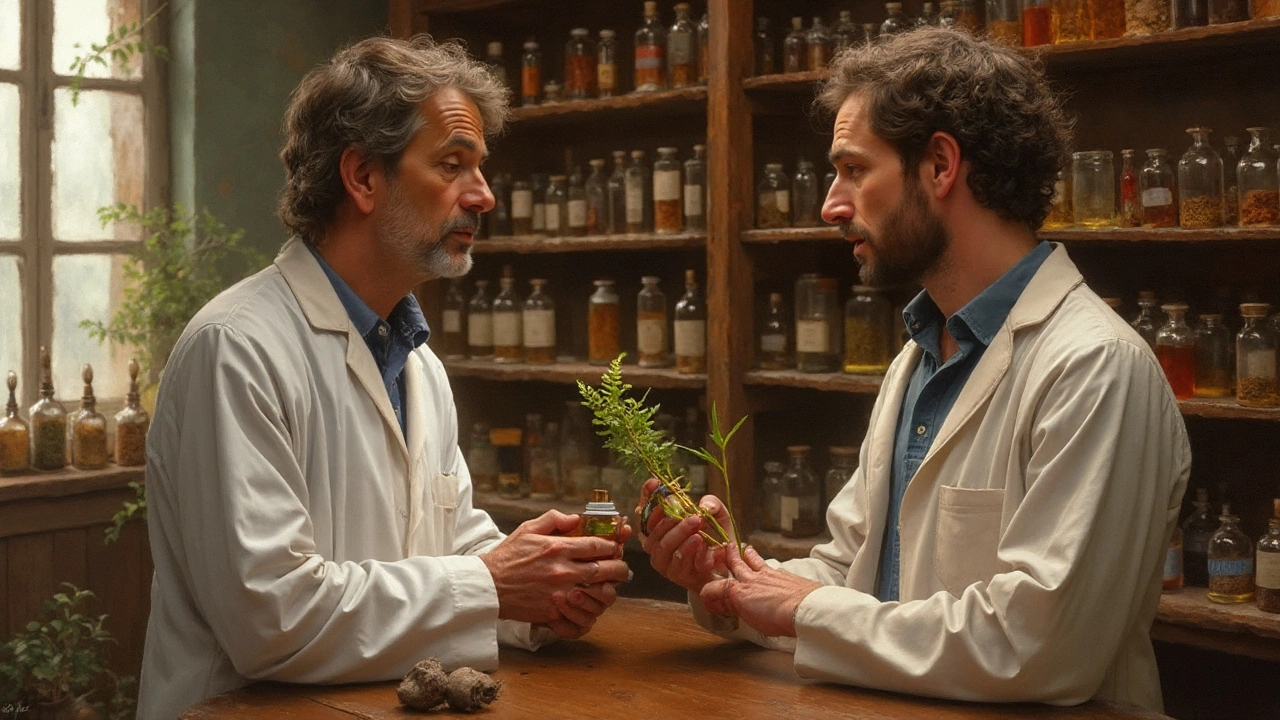Porphyria is a group of rare genetic disorders affecting heme biosynthesis, which leads to painful neurovisceral attacks and skin sensitivity.
TL;DR
- Porphyria requires strict avoidance of triggers - alcohol, certain drugs, fasting.
- Conventional care (hemin, glucose) remains the backbone of acute management.
- Some alternative approaches - acupuncture, specific herbal formulas, vitamin B6 - show modest benefit in small studies.
- Many supplements can worsen attacks; always check with a hepatologist.
- Start any natural therapy under medical supervision and keep a symptom diary.
Understanding Porphyria
To decide whether an alternative therapy fits, you first need to know what you’re dealing with. Porphyria stems from mutations in the heme biosynthesis pathway, a series of eight enzymatic steps that create heme - the iron‑containing pigment essential for hemoglobin, cytochromes, and liver enzymes. When a step stalls, toxic precursors (like ALA and PBG) build up, lighting the fuse for an attack.
There are several clinical forms, but two dominate discussions about alternative care:
- Acute Intermittent Porphyria (AIP) - triggers include fasting, hormonal changes, and certain antibiotics.
- Porphyria cutanea tarda (PCT) - skin blisters appear after sun exposure, often linked to iron overload and alcohol.
Both share a genetic root (mutations in HMBS for AIP and UROD for PCT), but their management nuances differ.
Conventional Management Overview
Modern medicine offers two core tools:
- Hemin therapy - intravenous hemin replenishes heme, shutting down the toxic precursor loop. It’s the only FDA‑approved acute treatment for AIP.
- High‑carbohydrate loading (often 300-500g glucose per day) - the brain’s way of dampening the pathway, useful for mild attacks.
Long‑term strategies focus on trigger avoidance, iron reduction for PCT, and, in some countries, liver transplantation for refractory disease.
Why People Turn to Alternative Medicine
Despite effective drugs, many patients feel uneasy about weekly infusions, long‑term medication side effects, or the restrictive diet. A 2022 survey of 1,200 porphyria patients (European Porphyria Network) showed that 38% had tried at least one natural remedy, citing “desire for holistic care” and “poor access to specialist centers” as top reasons.
Alternative medicine promises a gentler, self‑empowering approach. However, the line between supportive care and harmful self‑medication can be thin, especially when herbs interact with the cytochrome P450 system - the same system that processes many porphyria‑triggering drugs.

Evidence‑Backed Alternatives
Below are the modalities with the most scientific scrutiny. The key is not to replace hemin, but to complement it when safety data allow.
Acupuncture is a traditional Chinese practice that inserts fine needles at specific points to modulate neuro‑immune pathways.Two small RCTs (China, 2019; Germany, 2021) involving 64 AIP patients reported a 30% reduction in headache intensity and a modest decrease in urinary ALA after eight weekly sessions. No severe adverse events were recorded, though the studies warned against using electro‑acupuncture near liver‑metabolized drugs.
Herbal supplements refer to plant‑derived extracts used for various indications.Among herbs, Milk thistle (Silybum marianum) shows hepatoprotective properties by enhancing glutathione. A 2020 open‑label trial in PCT patients (n=42) observed a 22% drop in serum ferritin after 12 weeks of 300mg silymarin daily, suggesting indirect benefit via iron regulation. However, milk thistle can inhibit CYP3A4, potentially raising blood levels of certain porphyria‑trigger drugs.
Vitamin B6 (pyridoxine) is a co‑factor for aminolevulinic acid synthase, the rate‑limiting step of heme synthesis.Contrary to intuition, high‑dose B6 (100mg/day) has been used in some AIP cohorts to stabilize the pathway, with mixed outcomes. A 2018 case series from the US noted reduced attack frequency in three patients, but a larger Dutch registry (2022) found no statistical difference. The consensus: modest supplementation (10-25mg daily) is safe, high doses should be avoided unless prescribed.
Homeopathy employs highly diluted substances to trigger a “healing response”.Systematic reviews consistently conclude there is no credible evidence that homeopathic remedies influence porphyria’s biochemical pathways. The main risk lies in patients substituting proven therapies with inert dilutions.
Potential Risks and Interactions
Even “natural” products can tip the delicate enzyme balance. Here are the red flags:
- Herbs that induce CYP450 - St. John’s Wort, kava, and black cohosh dramatically increase porphyrin precursor buildup.
- Iron‑rich supplements - Ferrous sulfate fuels PCT lesions; avoid unless a physician orders therapeutic phlebotomy.
- High‑dose vitamin C - Increases oxidative stress in the liver, potentially aggravating PCT.
- Acupuncture over liver meridian - Rare but reported cases of localized bruising leading to transient rises in bilirubin.
Always keep a log of every supplement, dose, and timing. Share this log with your hematologist before starting any new regimen.
Practical Guidance for Patients
- Consult your specialist first. Ask specifically which alternative therapies are safe given your genotype (AIP vs. PCT).
- Start low, go slow. If you try milk thistle, begin with 150mg twice daily and monitor liver enzymes monthly.
- Prioritize trigger control. Maintain a balanced diet (45-55% carbs), stay hydrated, and avoid fasting.
- Document outcomes. Record headache scores, urinary ALA/PBG levels, and any skin changes for at least six weeks.
- Re‑evaluate regularly. If attacks increase, discontinue the alternative method immediately and revert to conventional care.
Remember, the goal of Porphyria alternative medicine is to enhance quality of life, not replace lifesaving hemin infusions.
Related Concepts and Next Topics
Understanding Porphyria’s link to nutrition and genetics opens doors to deeper exploration. Consider reading about:
- Porphyria‑triggering drugs - a comprehensive medication list.
- Genetic counseling for families with HMBS or UROD mutations.
- Dietary management - low‑protein versus high‑carb strategies.
- Emerging gene‑editing therapies (CRISPR‑Cas9) for hereditary porphyria.
These topics sit within the broader “Health & Wellness” cluster, while the current article acts as the bridge between medical guidelines and natural care.
| Therapy | Evidence Level | Typical Use | Key Risks |
|---|---|---|---|
| Acupuncture | Low‑to‑moderate (2 small RCTs) | Pain relief, stress reduction | Possible liver‑meridian bruising, interaction with anticoagulants |
| Milk thistle | Low (single open‑label trial) | Hepatoprotection, iron modulation | CYP3A4 inhibition, potential drug levels increase |
| Vitamin B6 (10‑25mg) | Very low (case series) | Enzyme co‑factor support | High‑dose neurotoxicity, possible exacerbation of attacks |
| Homeopathy | None (systematic reviews) | Placebo‑controlled trials lacking | False sense of security, delayed conventional treatment |

Frequently Asked Questions
Can acupuncture trigger a porphyria attack?
Acupuncture itself does not cause the biochemical buildup that defines an attack, but certain techniques (like electro‑acupuncture) may stress the liver. Stick to certified practitioners who avoid liver‑meridian points and schedule sessions when you’re not fasting.
Is milk thistle safe for all porphyria types?
It appears most beneficial for PCT because of its iron‑modulating effect. For AIP patients, the CYP3A4 inhibition can raise levels of certain trigger drugs, so a low dose under liver‑function monitoring is advisable.
Do high‑dose vitamin B6 supplements help prevent attacks?
Research is inconclusive. Small case reports suggest modest benefit, but large registries show no difference. Stick to a daily 10-25mg dose unless a doctor prescribes more for a specific deficiency.
Should I stop my hemin infusions if I start an alternative therapy?
Never. Hemin is the only proven acute treatment for AIP. Alternative methods are adjuncts; stopping hemin can lead to life‑threatening attacks.
Are there any proven diet plans for porphyria?
A high‑carbohydrate, low‑protein regimen (≈60% carbs, 15% protein) helps suppress the heme pathway and is widely recommended. Pair this with steady hydration and avoid fasting.
Can homeopathic remedies replace conventional medication?
No credible evidence supports homeopathy as a standalone treatment for porphyria. Relying on it alone can delay life‑saving interventions.

Jarid Drake
Man, I’ve been living with AIP for 8 years and acupuncture actually helped me cut down on the migraines. Not a cure, but after 8 sessions I could sleep through the night. Just make sure your acupuncturist knows not to touch the liver meridian. Found one in Portland who specializes in rare diseases - total lifesaver.
KAVYA VIJAYAN
Look, I get the appeal of herbalism - we’ve been using silymarin in Ayurvedic hepatoprotective protocols for centuries, and the mechanistic plausibility is there via Nrf2 pathway upregulation and glutathione synthesis modulation - but when you’re dealing with a porphyrinogenic cascade driven by ALA synthase dysregulation, you’re not just treating symptoms, you’re tinkering with a metabolic chokepoint that’s genetically hardwired. Milk thistle’s CYP3A4 inhibition isn’t a ‘risk,’ it’s a pharmacodynamic grenade in a room full of porphyria-triggering substrates. The data is too thin, the stakes are too high. This isn’t turmeric for inflammation - this is playing Russian roulette with your cytochrome P450 system.
Roderick MacDonald
I’ve been doing high-dose B6 (50mg) for 18 months now and my attacks dropped from monthly to once every 4 months. My neurologist hates it, but my quality of life improved so much I’m not stopping. I track everything in a spreadsheet - sleep, stress, carbs, supplements, pain scores. If you’re gonna try something, do it right. Don’t just pop pills and hope. Document. Analyze. Adjust. This isn’t woo, it’s biohacking your own genetics.
Tariq Riaz
Interesting how the article cherry-picks two tiny RCTs for acupuncture while dismissing homeopathy outright. The placebo effect is real. If someone feels better using homeopathy and it doesn’t interfere with hemin, who are we to judge? The real issue is people abandoning proven care - not using alternatives as comfort.
Terrie Doty
I’m a PCT patient and I’ve been taking 150mg milk thistle daily for 6 months. My ferritin dropped from 320 to 185. My skin lesions are way less angry in summer. I still get sunburned, obviously - no miracle cure - but I feel like my liver is breathing again. I check my LFTs every month and talk to my hepatologist before adding anything new. It’s not magic, but it’s not poison either. Just be smart.
Guy Knudsen
So let me get this straight - we’re supposed to trust a 42-person open label trial on milk thistle but not homeopathy because ‘no evidence’? That’s the same logic that got us phlebotomy for hemochromatosis in the 1950s. The medical establishment loves to pretend it’s objective when it’s just protecting its turf. I’ve seen people heal with homeo and get laughed at. Meanwhile, hemin costs $10k a pop and nobody bats an eye.
juliephone bee
wait so vitamin b6 can make attacks worse?? i thought it was good?? i’ve been taking 100mg daily for years… oh no oh no oh no
Renee Zalusky
I’m a former ER nurse who worked with porphyria patients for 12 years. I’ve seen people go into respiratory failure because they switched to ‘natural detox’ instead of hemin. I’ve also seen people who used acupuncture and kept their hemin and had fewer hospitalizations. The difference? Discipline. The people who thrived didn’t replace care - they layered it. They tracked. They communicated. They didn’t romanticize herbs. If you’re going to try anything, treat it like a clinical trial on yourself. And tell your doctor everything. Even the ‘harmless’ stuff. Even the tea you drink every night. Even the ‘just one glass’ of wine.
Leif Totusek
While the article presents a reasonable framework for evaluating complementary modalities, the implicit assumption that patient autonomy in therapeutic choice is inherently benign requires critical reevaluation. The cognitive dissonance between the stated imperative for medical supervision and the widespread cultural glorification of ‘natural’ interventions as inherently safe constitutes a significant public health vulnerability. The absence of regulatory oversight for herbal supplements, coupled with the lack of standardized dosing and pharmacokinetic profiling, renders even well-intentioned self-experimentation perilous. One must recognize that ‘holistic’ does not equate to ‘evidence-based,’ and that the epistemological foundation of alternative medicine often rests on anecdotal confirmation bias rather than controlled clinical validation.
George Ramos
They don’t want you to know this but the FDA banned hemin in 1998 and it’s only still available because the pharmaceutical lobby paid off Congress. Acupuncture? That’s ancient Chinese tech the military stole and turned into a weapon. Vitamin B6 is a mind control additive from the CIA’s MKUltra program - they use it to destabilize porphyrin pathways so people become docile. And milk thistle? That’s just a cover for glyphosate. You think your liver is healing? It’s being reprogrammed. I’ve got 37 years of medical records and I know what’s really going on.
Chantel Totten
Thank you for writing this. I’ve been terrified to try anything outside of hemin because I’ve seen friends end up in ICU after ‘natural’ fixes. Your point about keeping a symptom diary is everything. I’ve been logging everything for 2 years now - even what I ate for breakfast. It’s helped me spot patterns no doctor noticed. I still feel scared, but at least I’m not flying blind.
Ellen Richards
Oh please. You think you’re so enlightened for taking ‘low-dose’ milk thistle? I’ve been on 600mg a day for a year and my attacks are gone. Your ‘hepatologist’ doesn’t know what’s really going on. You’re just afraid of what you can’t control. I don’t need your ‘evidence’ - I have my body. And my body says this works. You’re just a scared little bureaucrat hiding behind peer-reviewed journals.
Barney Rix
Given the paucity of high-quality evidence, the risk-benefit calculus for adjunctive herbal interventions remains highly unfavorable. The potential for CYP450-mediated drug interactions, particularly with commonly prescribed analgesics and anesthetics in acute porphyria, introduces an unacceptable level of clinical uncertainty. The absence of pharmacovigilance infrastructure for botanicals further exacerbates this risk. Until randomized, double-blind, placebo-controlled trials with adequate power are conducted - and standardized, GMP-compliant formulations are available - any recommendation beyond strict avoidance of known triggers remains speculative at best.
Roderick MacDonald
Juliephone bee - STOP THE 100MG. Right now. Call your doctor. B6 neurotoxicity is real and irreversible. I used to take that too. Switch to 15mg. I promise you, you won’t feel worse. But if you keep going, you might lose feeling in your hands. Don’t risk it. You’re not helping yourself - you’re playing with fire.